Living History Timeline
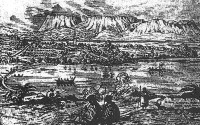
1840
The mission station was established at Kariri Point, Lake Tarawera. The first church was erected, a flimsy construction lined with raupo rushes. The church was burnt to the ground by a Maori worshipper smoking a pipe. A new...
Read more
The mission station was established at Kariri Point, Lake Tarawera. The first church was erected, a flimsy construction lined with raupo rushes. The church was burnt to the ground by a Maori worshipper smoking a pipe. A new more substantial building was made from local pit saw timber.
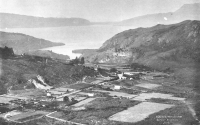
1852
A new mission station, a school built at Te Mu, and a Model Village (Te Wairoa), were established to cater for the drift of the Maori population to the more fertile Te Wairoa Valley; and for the growing number of tourists to...
Read more
A new mission station, a school built at Te Mu, and a Model Village (Te Wairoa), were established to cater for the drift of the Maori population to the more fertile Te Wairoa Valley; and for the growing number of tourists to the area who were there to visit the Pink and White Terraces.
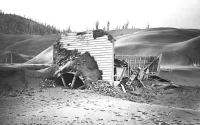
1857
A new flour mill was built and operated on Wairoa Stream. Unfortunately the flour mill was destroyed in the eruption, and the ruins of the flour mill now remain in the archaeological site.
Reverend Spencer introduced wheat...
Read more
A new flour mill was built and operated on Wairoa Stream. Unfortunately the flour mill was destroyed in the eruption, and the ruins of the flour mill now remain in the archaeological site.
Reverend Spencer introduced wheat to the Te Wairoa valley. The crops were large enough to justify a flour mill to be set up beside the Te Wairoa Stream. The Mill was abandoned when the residents turned from agricultural to tourism as their source of income. By the time of the eruption it had been abandoned for several years.
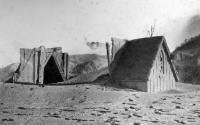
1862
Te Mu Church was completed at a time when serious signs of conflict became apparent between the Maori people and the crown, in the Te Wairoa area. In 1864 Mrs Spencer and her family left Te Wairoa through fears of their...
Read more
Te Mu Church was completed at a time when serious signs of conflict became apparent between the Maori people and the crown, in the Te Wairoa area. In 1864 Mrs Spencer and her family left Te Wairoa through fears of their safety and Spencer stayed on. In 1870 Spencer was forced to quit the field in which he had labored for so long. He moved to Maketu where he was joined by his family and remained for the next 30 years. The Church at Te Mu stood idle apart for occasional services for the next 22 years until it was destroyed in 1886 during the eruption.
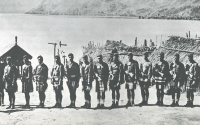
1865-1870
There were armed conflicts between Maori over land which disrupted the central North Island. Consequently, local Maori withdrew from the village back to Kariri...
Read more
There were armed conflicts between Maori over land which disrupted the central North Island. Consequently, local Maori withdrew from the village back to Kariri Point.
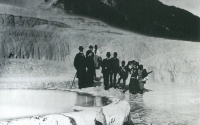
1874
Duke Alfred of Edinburgh visited the Pink and White Terraces, staying in the Spencer home at Te Wairoa. Following the unrest of 1870 tourism became an important industry and Te Wairoa Village grew rapidly to include hotels...
Read more
Duke Alfred of Edinburgh visited the Pink and White Terraces, staying in the Spencer home at Te Wairoa. Following the unrest of 1870 tourism became an important industry and Te Wairoa Village grew rapidly to include hotels and boarding houses. Reverend Spencer abandoned Te Wairoa in 1870 for Maketu where he remained until his death some 30 years later.
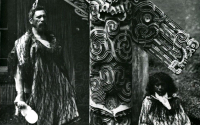
1886 May
Chief Aporo died of Typhoid fever. Some think the harsh words spoken between Aporo and Tuhoto Ariki (the village Tohunga) may have cause his...
Read more
Chief Aporo died of Typhoid fever. Some think the harsh words spoken between Aporo and Tuhoto Ariki (the village Tohunga) may have cause his death.
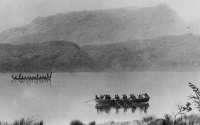
1886 May 31
A Phantom Canoe was sighted by a party of tourist accompanied by Guide Sophia on Lake Tarawera. This was believed to be a warning of impending...
Read more
A Phantom Canoe was sighted by a party of tourist accompanied by Guide Sophia on Lake Tarawera. This was believed to be a warning of impending danger.
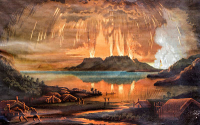
1886 June 10
Mt Tarawera erupted in the early hours of the morning (12.30am) followed by the explosion of Lake Rotomahana which buried Te Wairoa Village under a blanket of mud 1.5-2 metres deep. Approximately 153 lives were lost; 17 from...
Read more
Mt Tarawera erupted in the early hours of the morning (12.30am) followed by the explosion of Lake Rotomahana which buried Te Wairoa Village under a blanket of mud 1.5-2 metres deep. Approximately 153 lives were lost; 17 from Te Wairoa Village.
Sophia was the heroine of the night. Sixty two people sheltered in her small Whare. She moved with a number of the Tuhourangi Tribe people to Whakarewarewa.
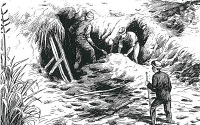
1886 June 14
Tuhoto Ariki (the village Tohunga or tribal priest) was blamed by many for the eruption. He was buried in his Whare for 4 days at which time angry Maori refused to dig him up. He was rescued by Europeans but died shortly...
Read more
Tuhoto Ariki (the village Tohunga or tribal priest) was blamed by many for the eruption. He was buried in his Whare for 4 days at which time angry Maori refused to dig him up. He was rescued by Europeans but died shortly after in hospital.
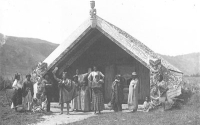
1892
Hinemihi; the village Maori Meeting House also sheltered many people during the eruption. Hinemihi was sold to the Earl of Onslow (the Governor of NZ) and shipped to England where it now resides in the grounds of Clandon...
Read more
Hinemihi; the village Maori Meeting House also sheltered many people during the eruption. Hinemihi was sold to the Earl of Onslow (the Governor of NZ) and shipped to England where it now resides in the grounds of Clandon Park, Surrey. Hinemihi is protected by the British National Trust.
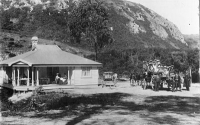
1906
Tearooms and accommodation were established at Te Wairoa (This later burned down). A tourist round trip route was developed and involved tourists transporting by coach and boat from Rotorua via Waimangu, Rotomahana, and Lake...
Read more
Tearooms and accommodation were established at Te Wairoa (This later burned down). A tourist round trip route was developed and involved tourists transporting by coach and boat from Rotorua via Waimangu, Rotomahana, and Lake Tarawera. The round trip brought visitors past the door who were curious of the aftermath of the eruption.
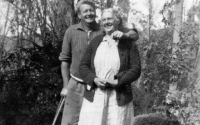
1916 - 1929
Cecil Way (grandson of Seymour Spencer) built tearooms which he continued to run for the next 20 years until 1929. In 1929 Cecil Way and his wife had decided to quit the running of the tearooms and lease the building to the...
Read more
Cecil Way (grandson of Seymour Spencer) built tearooms which he continued to run for the next 20 years until 1929. In 1929 Cecil Way and his wife had decided to quit the running of the tearooms and lease the building to the Meir family. A year later they also decided that they didn't want to continue working there and left the district. The tearooms remained vacant, and although nothing was vandalised the place fell in to disrepair. Little had been done to explore the surrounding grounds and the village of the past slumbered on beneath its heavy coat of volcanic mud.
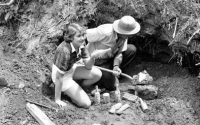
1931 - 1939
Reg and Violet Smith bought the site of Te Wairoa. Violet re-opened the tearooms.
Early excavations began by Reg and Violet Smith and their two sons Dudley and Basil. They also built the waterfall...
Read more
Reg and Violet Smith bought the site of Te Wairoa. Violet re-opened the tearooms.
Early excavations began by Reg and Violet Smith and their two sons Dudley and Basil. They also built the waterfall trail.
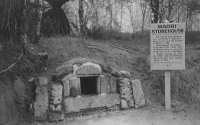
1932
The stone storehouse was uncovered during a picnic among hawthorns. Violet Smith used a copper penny to scrape the earth away. Carved stone lay underneath. This was a rare example of a Maori Stone...
Read more
The stone storehouse was uncovered during a picnic among hawthorns. Violet Smith used a copper penny to scrape the earth away. Carved stone lay underneath. This was a rare example of a Maori Stone Carving.
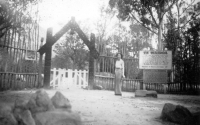
1945
Development of the Buried Village Attraction began after the Second World War. Dudley returned from the war, however; unfortunately Basil did...
Read more
Development of the Buried Village Attraction began after the Second World War. Dudley returned from the war, however; unfortunately Basil did not.
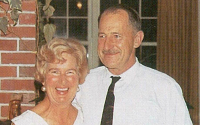
1958
Dudley took over the business after Reg and Violet Smith retired to live at Mount Maunganui. Dudley and Nora operated and developed the business for 40...
Read more
Dudley took over the business after Reg and Violet Smith retired to live at Mount Maunganui. Dudley and Nora operated and developed the business for 40 years.
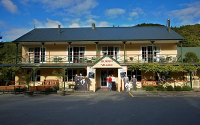
1977
The tearoom building that stood on the site since 1910 was replaced by a new complex which was modelled from the Terraces...
Read more
The tearoom building that stood on the site since 1910 was replaced by a new complex which was modelled from the Terraces Hotel.
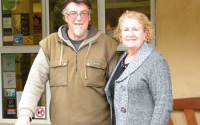
1981
Pat & Pam (nee Smith) McGrath took over as General Managers and continue as such to this day. After more than 80 years the business is still owned and operated by the Smith...
Read more
Pat & Pam (nee Smith) McGrath took over as General Managers and continue as such to this day. After more than 80 years the business is still owned and operated by the Smith family.
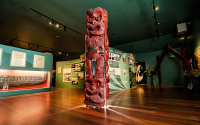
1999
A purpose built museum was added to the existing building to house collections and relics of the Tarawera eruption; and now displays exhibits of the early settlers and The Pink and White Terraces. The cave which took...
Read more
A purpose built museum was added to the existing building to house collections and relics of the Tarawera eruption; and now displays exhibits of the early settlers and The Pink and White Terraces. The cave which took visitors through to the waterfall collapsed. A new waterfall trail was built.
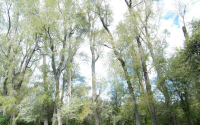
2012
In 1852 poplar trees were felled to make fence posts for the model village. Following the eruption the row of fence posts sprouted because of the rich mineral soil and grew to an avenue of trees which reached approximately...
Read more
In 1852 poplar trees were felled to make fence posts for the model village. Following the eruption the row of fence posts sprouted because of the rich mineral soil and grew to an avenue of trees which reached approximately 140 ft high. Due to safety reasons the trees were felled in May of 2012.
Timeline

1840
The mission station was established at Kariri Point, Lake Tarawera. The first church was erected, a flimsy construction lined with raupo rushes. The church was burnt to the ground by a Maori worshipper smoking a pipe. A new...The mission station was established at Kariri Point, Lake Tarawera. The first church was erected, a flimsy construction lined with raupo rushes. The church was burnt to the ground by a Maori worshipper smoking a pipe. A new more substantial building was made from local pit saw timber.

1852
A new mission station, a school built at Te Mu, and a Model Village (Te Wairoa), were established to cater for the drift of the Maori population to the more fertile Te Wairoa Valley; and for the growing number of tourists to...A new mission station, a school built at Te Mu, and a Model Village (Te Wairoa), were established to cater for the drift of the Maori population to the more fertile Te Wairoa Valley; and for the growing number of tourists to the area who were there to visit the Pink and White Terraces.

1857
A new flour mill was built and operated on Wairoa Stream. Unfortunately the flour mill was destroyed in the eruption, and the ruins of the flour mill now remain in the archaeological site. Reverend Spencer introduced wheat...A new flour mill was built and operated on Wairoa Stream. Unfortunately the flour mill was destroyed in the eruption, and the ruins of the flour mill now remain in the archaeological site.
Reverend Spencer introduced wheat to the Te Wairoa valley. The crops were large enough to justify a flour mill to be set up beside the Te Wairoa Stream. The Mill was abandoned when the residents turned from agricultural to tourism as their source of income. By the time of the eruption it had been abandoned for several years.

1862
Te Mu Church was completed at a time when serious signs of conflict became apparent between the Maori people and the crown, in the Te Wairoa area. In 1864 Mrs Spencer and her family left Te Wairoa through fears of their...Te Mu Church was completed at a time when serious signs of conflict became apparent between the Maori people and the crown, in the Te Wairoa area. In 1864 Mrs Spencer and her family left Te Wairoa through fears of their safety and Spencer stayed on. In 1870 Spencer was forced to quit the field in which he had labored for so long. He moved to Maketu where he was joined by his family and remained for the next 30 years. The Church at Te Mu stood idle apart for occasional services for the next 22 years until it was destroyed in 1886 during the eruption.

1865-1870
There were armed conflicts between Maori over land which disrupted the central North Island. Consequently, local Maori withdrew from the village back to Kariri...There were armed conflicts between Maori over land which disrupted the central North Island. Consequently, local Maori withdrew from the village back to Kariri Point.

1874
Duke Alfred of Edinburgh visited the Pink and White Terraces, staying in the Spencer home at Te Wairoa. Following the unrest of 1870 tourism became an important industry and Te Wairoa Village grew rapidly to include hotels...Duke Alfred of Edinburgh visited the Pink and White Terraces, staying in the Spencer home at Te Wairoa. Following the unrest of 1870 tourism became an important industry and Te Wairoa Village grew rapidly to include hotels and boarding houses. Reverend Spencer abandoned Te Wairoa in 1870 for Maketu where he remained until his death some 30 years later.

1886 May
Chief Aporo died of Typhoid fever. Some think the harsh words spoken between Aporo and Tuhoto Ariki (the village Tohunga) may have cause his...Chief Aporo died of Typhoid fever. Some think the harsh words spoken between Aporo and Tuhoto Ariki (the village Tohunga) may have cause his death.

1886 May 31
A Phantom Canoe was sighted by a party of tourist accompanied by Guide Sophia on Lake Tarawera. This was believed to be a warning of impending...A Phantom Canoe was sighted by a party of tourist accompanied by Guide Sophia on Lake Tarawera. This was believed to be a warning of impending danger.

1886 June 10
Mt Tarawera erupted in the early hours of the morning (12.30am) followed by the explosion of Lake Rotomahana which buried Te Wairoa Village under a blanket of mud 1.5-2 metres deep. Approximately 153 lives were lost; 17 from...Mt Tarawera erupted in the early hours of the morning (12.30am) followed by the explosion of Lake Rotomahana which buried Te Wairoa Village under a blanket of mud 1.5-2 metres deep. Approximately 153 lives were lost; 17 from Te Wairoa Village.
Sophia was the heroine of the night. Sixty two people sheltered in her small Whare. She moved with a number of the Tuhourangi Tribe people to Whakarewarewa.

1886 June 14
Tuhoto Ariki (the village Tohunga or tribal priest) was blamed by many for the eruption. He was buried in his Whare for 4 days at which time angry Maori refused to dig him up. He was rescued by Europeans but died shortly...Tuhoto Ariki (the village Tohunga or tribal priest) was blamed by many for the eruption. He was buried in his Whare for 4 days at which time angry Maori refused to dig him up. He was rescued by Europeans but died shortly after in hospital.

1892
Hinemihi; the village Maori Meeting House also sheltered many people during the eruption. Hinemihi was sold to the Earl of Onslow (the Governor of NZ) and shipped to England where it now resides in the grounds of Clandon...Hinemihi; the village Maori Meeting House also sheltered many people during the eruption. Hinemihi was sold to the Earl of Onslow (the Governor of NZ) and shipped to England where it now resides in the grounds of Clandon Park, Surrey. Hinemihi is protected by the British National Trust.

1906
Tearooms and accommodation were established at Te Wairoa (This later burned down). A tourist round trip route was developed and involved tourists transporting by coach and boat from Rotorua via Waimangu, Rotomahana, and Lake...Tearooms and accommodation were established at Te Wairoa (This later burned down). A tourist round trip route was developed and involved tourists transporting by coach and boat from Rotorua via Waimangu, Rotomahana, and Lake Tarawera. The round trip brought visitors past the door who were curious of the aftermath of the eruption.

1916 - 1929
Cecil Way (grandson of Seymour Spencer) built tearooms which he continued to run for the next 20 years until 1929. In 1929 Cecil Way and his wife had decided to quit the running of the tearooms and lease the building to the...Cecil Way (grandson of Seymour Spencer) built tearooms which he continued to run for the next 20 years until 1929. In 1929 Cecil Way and his wife had decided to quit the running of the tearooms and lease the building to the Meir family. A year later they also decided that they didn't want to continue working there and left the district. The tearooms remained vacant, and although nothing was vandalised the place fell in to disrepair. Little had been done to explore the surrounding grounds and the village of the past slumbered on beneath its heavy coat of volcanic mud.

1931 - 1939
Reg and Violet Smith bought the site of Te Wairoa. Violet re-opened the tearooms. Early excavations began by Reg and Violet Smith and their two sons Dudley and Basil. They also built the waterfall...Reg and Violet Smith bought the site of Te Wairoa. Violet re-opened the tearooms.
Early excavations began by Reg and Violet Smith and their two sons Dudley and Basil. They also built the waterfall trail.

1932
The stone storehouse was uncovered during a picnic among hawthorns. Violet Smith used a copper penny to scrape the earth away. Carved stone lay underneath. This was a rare example of a Maori Stone...The stone storehouse was uncovered during a picnic among hawthorns. Violet Smith used a copper penny to scrape the earth away. Carved stone lay underneath. This was a rare example of a Maori Stone Carving.

1945
Development of the Buried Village Attraction began after the Second World War. Dudley returned from the war, however; unfortunately Basil did...Development of the Buried Village Attraction began after the Second World War. Dudley returned from the war, however; unfortunately Basil did not.

1958
Dudley took over the business after Reg and Violet Smith retired to live at Mount Maunganui. Dudley and Nora operated and developed the business for 40...Dudley took over the business after Reg and Violet Smith retired to live at Mount Maunganui. Dudley and Nora operated and developed the business for 40 years.

1977
The tearoom building that stood on the site since 1910 was replaced by a new complex which was modelled from the Terraces...The tearoom building that stood on the site since 1910 was replaced by a new complex which was modelled from the Terraces Hotel.

1981
Pat & Pam (nee Smith) McGrath took over as General Managers and continue as such to this day. After more than 80 years the business is still owned and operated by the Smith...Pat & Pam (nee Smith) McGrath took over as General Managers and continue as such to this day. After more than 80 years the business is still owned and operated by the Smith family.

1999
A purpose built museum was added to the existing building to house collections and relics of the Tarawera eruption; and now displays exhibits of the early settlers and The Pink and White Terraces. The cave which took...A purpose built museum was added to the existing building to house collections and relics of the Tarawera eruption; and now displays exhibits of the early settlers and The Pink and White Terraces. The cave which took visitors through to the waterfall collapsed. A new waterfall trail was built.

2012
In 1852 poplar trees were felled to make fence posts for the model village. Following the eruption the row of fence posts sprouted because of the rich mineral soil and grew to an avenue of trees which reached approximately...In 1852 poplar trees were felled to make fence posts for the model village. Following the eruption the row of fence posts sprouted because of the rich mineral soil and grew to an avenue of trees which reached approximately 140 ft high. Due to safety reasons the trees were felled in May of 2012.







Connect with Us
Facebook YouTube Instagram Tripadvisor Blog Email